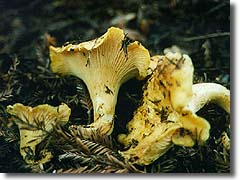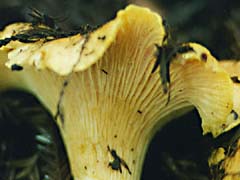Cantharellus cibarius
Chanterelle
Cantharellaceae
(Chanterelle Family)
Cap: From broadly convex when young to planar, depressed, or vase-shaped when matured; smooth, non-viscid surface; orange to gold to yellow in color, but may bleach lighter in sunlight; thick white to yellow flesh, peppery taste and fruity smell. 3 to 15 cm (1 to 6 inches) across.
Gills: Underside, actually - primitive, blunt and foldlike, forked and branching decurrent (running down the stalk); usually colored slightly lighter than cap but often staining orange with age.
Stalk: 2 to 10 cm long, 1 to 5 cm thick, equal or tapered downward, central or offset; solid, firm and smooth; colored like cap, discoloring to ornate/brown with age or when bruised.
Veil: None.

Cantharellus cibarius
600x450
JPEG - 48K
Spores: Cream or yellow print, occasionally pink; elliptical and smooth.
Habitat: Scattered to gregarious groupings on ground in woods, in clearings, and on edges of open fields. It seems to like oaks, but I've found them with manzanita, pine, madrone or toyon as well. I am protective of my hard-sought patches, so I'm not giving any specifics away, but they've been found in the inland canyons along our coast from Pacifica to Waddell Creek.
Further Description and Comment: Chanterelles have a long growing season - from late fall until almost spring - and will bloom successive crops if rainfall is steady. They may take a bit of poking to find, as they often hide under the humus of dead leaves and needles, but if you find one you'll usually find at least a dozen more.
Collecting and Consumption: Collecting Chanterelles for market is a lucrative business - fortunately, we do not have the dense crop that is found on the northern coast, so competition from commercial collectors is minimal until you get a bit further south toward Santa Cruz. Property owners are usually amenable to letting you forage as long as you give them a good sampling of your finds in return - a good policy to follow for anyone who facilitates any successful hunt.
Fresh is the best - clean, dry fresh chanterelles will keep up to 10 days in the refrigerator if they are stored loosely in a paper bag or spread out in a box - I store mine spread out in a box out in the unheated garage. I also dry extras I can't use up in a standard dehydrator - some folks don't like to dry them, as they get a bit chewy when reconstituted, but I don't mind the extra texture and the flavor is retained in a very concentrated form. And you can have scrambled eggs with chanterelles or Cream of Chanterelle Soup in July.
Chanterelles also naturally hold a lot of water, so I also recommend the "dry saute" method for cooking: Slice them up and place in a nonstick pan over high heat, stirring them about so their surfaces don't burn - within a minute or so, they will release their moisture, which is then boiled off, or you can retain a bit for flavoring sauces or soups. With fresh mushrooms picked that afternoon, this is all the preparation I'll give them. It also works well for utilizing soggy ones if done soon after picking. It concentrates the flavors and aromas intensely, and I recommend it as a first step before preparing recipes like the one below from Cafe Beaujolais that use extra oils.
Sautéed Chanterelles with Sesame and Ginger - for four servings
8 ounces fresh chanterelle mushrooms, as dry as possible
2 t canola, safflower, or peanut oil
Fine sea salt and freshly ground pepper to taste
1 t sesame oil
1 t minced garlic (1 clove)
2 t peeled, grated fresh ginger
2 T minced green onions (optional)
1 t soy sauce
1 T coarsely chopped cilantro
To prepare the mushrooms: Use a clean vegetable or pastry brush and a kitchen towel and brush and wipe the mushrooms clean. Be especially careful to brush away dirt in the gills. Any deeply embedded grit can be cut away with a paring knife. If the mushrooms are large, cut them into large bite-sized pieces (usually halving, quartering, or thickly slicing lengthwise leaves wild mushrooms most attractive and reminiscent of their original shape). If mushroom buttons are small, leave them whole.
Heat the canola oil in a 10- to 12-inch skillet, one large enough to hold all of the mushrooms. (They can be slightly crowded at first since they will shrink as they cook). When the oil is hot, add the mushrooms all at once and cook quickly over high heat, stirring or tossing frequently, for about 2 minutes, until just beginning to soften.
Season with salt and pepper, toss a few more times, then clear a space in the center of the pan and add the sesame oil, garlic, and ginger. Lower the heat to medium and continue to cook, stirring just the garlic and ginger for another minute until they are fragrant and just starting to color.
Add the minced green onions, stir for another 15 seconds or so (do not let the garlic burn!), and stir or toss the seasonings together with the mushrooms.
Add the soy sauce and chopped cilantro, toss a few more times, taste
for seasoning, and serve.
--------------------------------------------------------------
© copyright 1998 Margaret Fox & Christopher Kump, Cafe Beaujolais
posted 24 November 1998
